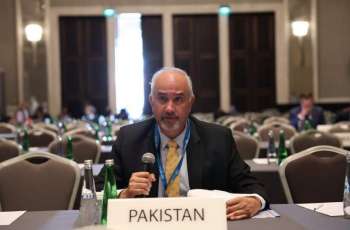WASHINGTON (Pakistan Point News / Sputnik - 27th March, 2020) The record $2 trillion US coronavirus (COVID-19) stimulus might help prevent bankruptcy by providing money to both big and small American businesses, but it might still not stop the world's top economy from going into recession, economists told Sputnik.
Republicans on President Donald Trump's side and their Democratic rivals in the Senate passed on Wednesday the biggest economic rescue package in American history that allocated $850 billion in aid to companies, and another $1.15 trillion to fund state and city programs, employment insurance plans and money for ordinary Americans.
Even so, some experts believe the gigantic undertaking may not prevent the end of a decade-long streak of economic growth - the longest the United States has experienced
"We are still going to have a very deep recession, possibly depression," said Brian Riedl, senior fellow at the Manhattan Institute. "But as long as we don't lose the companies, and have families become totally insolvent, the economy will be in a position to recover quickly whenever this ends."
Asked to quantify the decline, he said it could be "a significant economic contraction, as high as 20 to 30 percent at some point."
"By minimizing layoffs and minimizing bankruptcies, we're not as much preventing the recession, as much as we're positioning the economy to recover quickly after people go back to work," he added.
Ratings agency Moody's projected on Wednesday the US economy will contract by a cumulative 4.3 percent over the first and second quarters, warning that the Group of 20 economies, which represent the world's richest nations, will experience a shock like never before from the pandemic.
US gross domestic product (GDP) growth was at 2.1 percent in the fourth quarter of 2019. A recession is technically defined as two straight quarters of negative growth.
Some forecasters on Wall Street, including Goldman Sachs, still expect to see positive US GDP growth of around 1 percent for the first quarter of this year as the widespread disruption of the economy only began in mid-March. But many expect double-digit declines in the second quarter, including Raymond James, which forecasts a drop of as much as 15 percent.
Riedl said the greatest challenge to the stimulus plan was uncertainty over how long the economy would remain shuttered.
As of Thursday, more than half of the 50 US states remained under lockdown, keeping more than 100 million people off work and other activity as authorities struggle to contain a pandemic which has infected nearly 70,000 Americans and killed at least 1,000.
NO CERTAINTY WHEN ECONOMY CAN REOPEN
Trump has expressed a desire to reopen at least some sections of the US economy by Easter, which falls on April 12. But some health experts and state officials disagree, saying aggressive social distancing must be maintained to flatten the curve in the face of the outbreak.
"The challenge is that despite the high costs, this is only going to cover perhaps two months," said Riedl. "So, what happens in two months if the quarantine has not ended? We're going to need to come back and perhaps spend another $1 trillion. Our borrowing capacity is not unlimited and the national debt impact is enormous."
US national debt currently stands at $23 trillion. At face value, the COVID-19 stimulus could take the figure to $25 trillion, barring other budget deficits. But White House Economic Adviser Larry Kudlow said on Tuesday the ultimate rescue bill for the economy could be as high as $6 trillion.
"With lockdown and schools closed, travel and hospitality industries drastically at a standstill demand, eventually all sectors will be impacted badly," said Ramesh Mohan, professor of economics at Bryant University in Rhode Island. "Unemployment could go up to 20 percent."
INADEQUATE FUNDING IN SOME CASES
New York Governor Andrew Cuomo said on Wednesday the state would receive just under $4 billion in funding from the huge package compared to the estimated $15 billion hit its budget would take.
Mohan said the stimulus was inadequate in the aid it provided directly to the Medicaid program, which states relied on to provide health coverage to elderly and poor Americans.
"The bill does not provide means to directly deal with the spread of the virus," Mohan said. "In order to limit the economic destruction, we need to minimize the spread of COVID-19. Currently, it's not being done fast enough."
The spread of the virus and the number of cases are rising by thousands a day, stretching the capacity of medical systems, he added.
Riedl of Manhattan Institute said, at its core, the $500 billion funding for large corporations under the stimulus was similar to the loans and loan guarantees provided by the Bush administration in 2008 under the Troubled Assets Relief Program during the financial crisis.
The $350 billion aid for small businesses was similar to the stimulus launched by President Barack Obama right after he took office in 2009 as the Great Recession was underway.
"Another interesting element of the aid to small businesses is that they are intended to be grants, meaning if you maintain your payroll and don't lay anybody off, you get to keep the money and not pay it back," Riedl said. "Logically, it should keep a lid on unemployment, but I'm not holding my breath."



